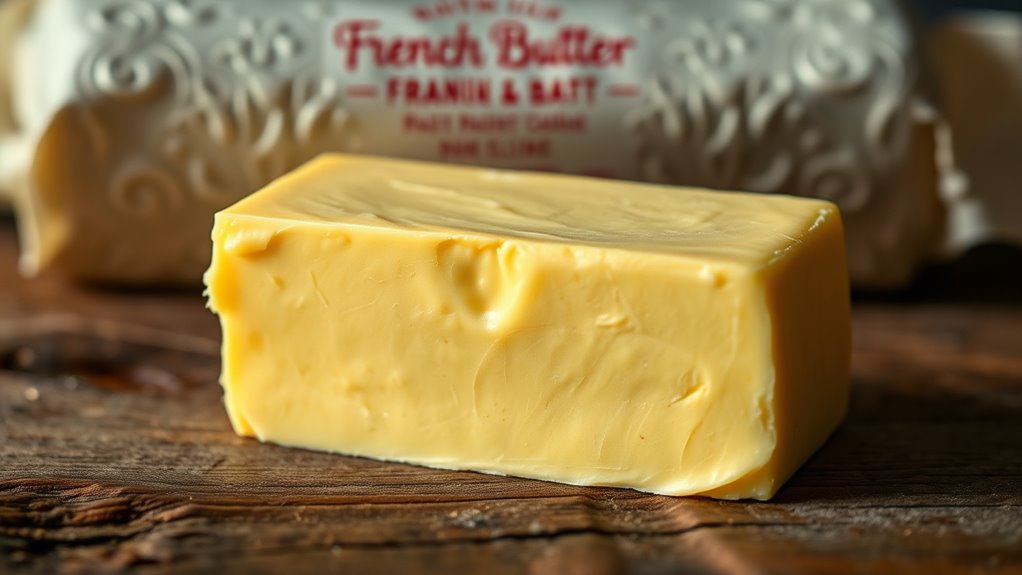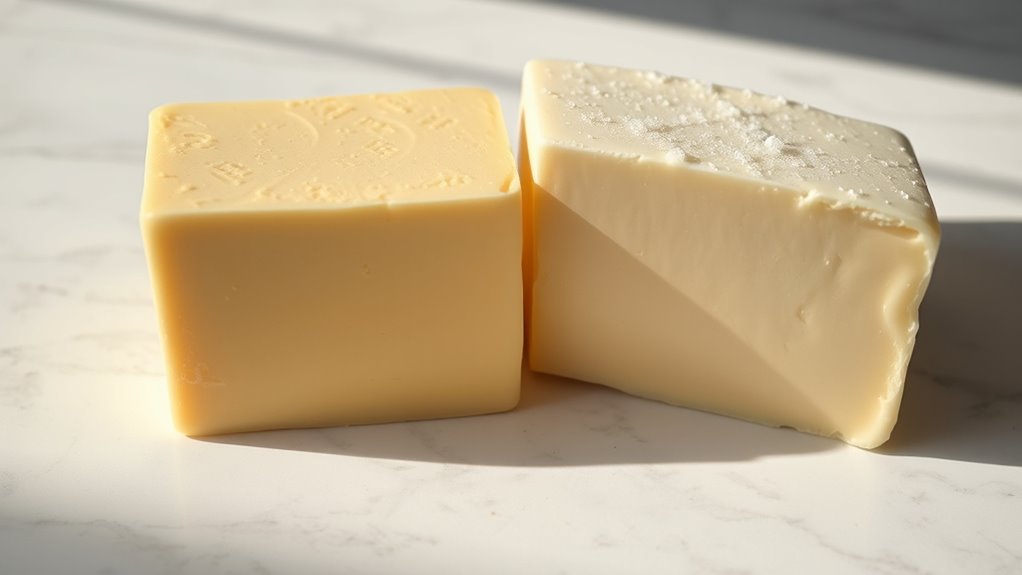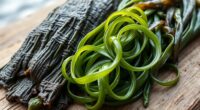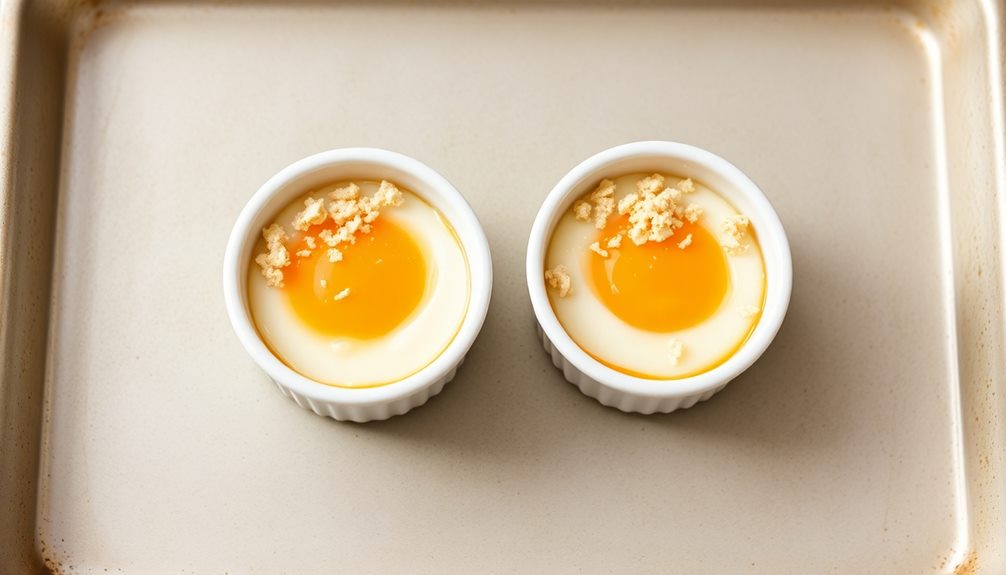French butter typically has a higher minimum fat content, usually at least 82%, reflecting traditional techniques and a focus on quality and flavor. In the EU, standards emphasize richer textures and complex tastes achieved through small-batch, artisanal methods handed down through generations. In contrast, US regulations may have different requirements, often resulting in varied fat levels. If you’re curious about how these standards shape the butter you enjoy, there’s more to discover beyond the basics.
Key Takeaways
- EU regulations generally require a minimum of 82% milk fat for butter, emphasizing richness and traditional craftsmanship.
- French artisanal butter often exceeds EU standards, focusing on high fat content for complex flavor development.
- US standards for butter may allow slightly lower fat content but still prioritize quality and natural production methods.
- Higher fat content in French butter supports aging processes that enhance flavor complexity and authenticity.
- Both regions value craftsmanship, but EU standards emphasize stricter minimums to maintain traditional, high-quality butter profiles.

Have you ever wondered what makes French butter stand out from others? One key factor is the emphasis on artisanal production, which involves traditional methods passed down through generations. Unlike mass-produced butters, French artisans focus on small-batch techniques that preserve flavor and quality. This approach often includes careful butter aging, a process where the butter is stored in controlled conditions to develop richer, more complex flavors. Butter aging allows the fats and proteins to harmonize, creating a nuanced taste profile that’s difficult to replicate in industrial processes. When you buy French butter, you’re often experiencing the culmination of careful craftsmanship and patience, which elevates it beyond standard spreads. Incorporating natural materials like wood and linen in production environments can also influence the flavor profile by emphasizing authenticity and quality. In contrast, the United States has different regulatory standards for butter content, especially regarding the minimum milk fat percentage. The EU, including France, typically mandates a higher minimum fat content—around 82%—which ensures the butter retains a creamy texture and intense flavor. This higher fat content also lends itself well to artisanal production methods and butter aging, both of which are central to French dairy traditions. Additionally, the emphasis on artisanal techniques underscores a commitment to quality that distinguishes French butter from mass-market options. The focus on quality over quantity means French butter often undergoes a more delicate process, where aging enhances its richness and depth. Incorporating traditional dairy practices into production can further contribute to the distinctive qualities of French butter. Furthermore, these traditional practices often involve natural fermentation, which enhances flavor complexity and authenticity. When you encounter French butter in shops or markets, you’re often getting a product that has been crafted with these standards in mind, resulting in a distinctive taste that’s closely tied to its production methods.
Frequently Asked Questions
How Does Butter Content Affect French Butter’s Flavor Profile?
You’ll notice that butter content directly impacts flavor depth and texture variation in French butter. Higher butter content enhances richness and creates a creamier, smoother texture, which intensifies the butter’s flavor. Lower butter content results in a lighter taste and slightly firmer texture. By understanding these differences, you can better appreciate the unique qualities of French butter, whether you’re baking or simply spreading it on bread.
Are There Legal Differences in Butter Labeling Between France and the US?
Imagine opening a box of butter with a delicate, golden hue—each country’s rules shape that experience. In France and the US, regulatory compliance influences labeling standards, ensuring clarity and authenticity. While France emphasizes traditional qualities, the US may have more flexible guidelines. These legal differences help you trust what you’re buying, guiding your choices and ensuring you savor genuine, high-quality butter no matter where you are.
What Impact Does Butter Content Have on French Baking Techniques?
You’ll notice that butter content considerably impacts your French baking techniques. Higher butter content enhances butter melting, creating a richer, smoother texture in baked goods. This results in a tender, flaky crust or melt-in-your-mouth pastries. If the butter content is lower, your baked texture might be less delicate and more crumbly. Paying attention to butter quality and amount helps you achieve authentic French baking results with perfect butter melting and ideal textures.
How Is Butter Content Measured and Verified in International Trade?
Like a Morse code message from a bygone era, butter content in international trade is measured through moisture measurement techniques and rigorous quality assurance protocols. You verify butter’s fat content via standardized tests, such as the Gerber method or near-infrared spectroscopy, ensuring compliance with EU or US standards. These methods guarantee consistency, allowing traders and regulators to trust the butter’s quality and maintain fair market practices worldwide.
Do Consumer Preferences Influence Butter Content Standards in France and the US?
Consumer preferences definitely influence butter standards in France and the US. In France, people value butter with higher butterfat content, leading to stricter standards that reflect these tastes. Meanwhile, US standards balance consumer demands for affordability and consistency, often resulting in slightly lower butterfat levels. Your preferences shape producers’ decisions, which in turn shape the butter standards that meet what consumers want, ensuring that products align with local tastes and expectations.
Conclusion
Did you know that French butter often contains at least 82% milkfat, compared to the U.S. standard of 80%? This small difference elevates French butter’s richness and flavor. Understanding these standards helps you choose quality products and appreciate regional differences. Next time you enjoy butter, remember that these subtle regulations shape what ends up on your table. Whether in France or the US, knowing the standards enhances your appreciation for the butter you love.










